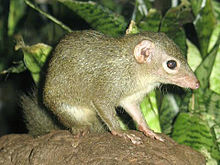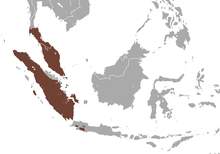- Common Treeshrew
-
Common Treeshrew 
Conservation status Scientific classification Kingdom: Animalia Phylum: Chordata Class: Mammalia Order: Scandentia Family: Tupaiidae Genus: Tupaia Species: T. glis Binomial name Tupaia glis
Diard & Duvaucel, 1820[2]
Common Treeshrew range The Common Treeshrew (Tupaia glis) is a small mammal in the treeshrew family Tupaiidae, and is native to Thailand, Malaysia and Indonesia. It has been listed as Least Concern by IUCN as it remains common and displays some adaptability to ongoing habitat loss.[1]
Contents
Description
The common treeshrew is one of the largest among treeshrews. Average body length is between 16–21 cm (6.3–8.3 in), and average weight is around 190g, with varying colours of reddish brown, greyish or black upper parts and whitish belly. Its long bushy tail is dark greyish brown and almost reaches the length of the body. The paws are bare with sharp nails, and there is a naked patch of skin above its long nose. Both sexes are similar. The measurements of the Tupaia glis according to 21 specimens are head- to-body length: 170mm to 235mm, tail length: 170mm to 242mm and hind foot: 45mm to 56mm.[3] The common treeshrew usually has a pale stripe on each shoulder.
There are two subspecies T.g. longipes and T.g. salatana, with T.g. longipes being duller in coloration than T.g. salatana. The underparts of longipes are dull buff to reddish buff, and the underside of the tail is greyish. The underparts and underside of the tail are dark reddish in salatana. Similar species are Tupaia splendidula and Tupaia montana.
Distribution and habitat
Common treeshrews occur south of about 10° N latitude in southern Thailand through mainland Malaysia and adjacent coastal islands to Singapore.[1] In Indonesia, they are found on the islands of Siberut, Batu, Sumatra, Java, Bangka, Riau, Lingga and Anambas.[4] Usually they are found in primary dipterocarp forest, but are tolerant to some degree of habitat modification. They have also been recorded from secondary forest, plantations, fruit orchards and trees near housing areas.[5]
This species is probably present throughout the lowlands and hills up to 1,100 m (3,600 ft) in the Kelabit Highlands of Borneo. The subspecies T.g. longipes occurs in the north of Borneo, in Sarawak, and in East Kalimantan including Sabah. The subspecies T.g. salatana occurs in the south of Rajang River and Kayan River in Borneo.[3]
Common treeshrews inhabit protected areas, including Pasoh Forest Reserve on the Malay Peninsula and Krau Wildlife Reserve.[1]
Ecology and behavior
Common treeshrews are active during the day, and forage for food alone or in pairs, mainly on the ground, among shrubs and tree holes. They feed on fruits, seeds, leaves, and insects especially ants and spiders.[6] They are also reported to catch lizards.
They are very agile in climbing both large vertical tree trunks and bushes, and occasionally jump from stems of a young tree to that of another as much as 60 cm (24 in) away. Their climbing is concentrated in lower heights. They frequently scent-mark their territories by chest and ano-genital rubbing with a secretion from glands on chest and scrotum. Adult males are more secretory than females and juveniles. In the Bukit Timah Nature Reserve, mean home ranges of adult males were estimated at 10,174 m2 (109,510 sq ft), of adult females at 8,809 m2 (94,820 sq ft), of juvenile males at 7,527 m2 (81,020 sq ft), and of juvenile females at 7,255 m2 (78,090 sq ft), with partial overlaps between male and female ranges varying from 0.4% to 56.8%. Home ranges of adult residents of the same sex overlap to a lesser degree than those of opposite sexes. A male’s range may include the ranges of two or three females. A high overlap between ranges of one adult male and one adult female indicates that they form a stable pair. Juvenile ranges of either sex adjoin or overlap with ranges of adults, suggesting that the juveniles are family members. Individuals of the same sex are involved in aggressive territorial chases.[7]
Juvenile males depart from their family's territory sooner than juvenile females.[6]
Reproduction
Both sexes of common treeshrews are sexually mature at the age of about 3 months. In captiity, females give birth for the first time at the age of about 4.5 months, usually in February. A postpartum oestrus results in more births in April. Their oestrus cycle is 8 to 39 days, and the gestation period lasts 40 to 52 days, after which a litter of one to three individuals is born. The new born offspring weighs about 10 to 12 grams. Females suckle their young every other day, and neglect their young as long as possible. They won’t even be able to identify their own young if they didn’t mark them with the scent produced from glands in their sternum and abdomen. Juveniles leave the nest between 25 to 35 days of age. Longevity of a captive common treeshrew has been recorded as 12 years and 5 months.[6]
From October to December, common treeshrews are reproductively inactive.[7] The mating season starts at the onset of the monsoon season in December and lasts until February. Oestrus and pre-oestrus behavior is characterized by adult males pursuing adult females. Males emit chattering, and appear to be extremely excited. They also chase each other and fight. Females do not actively choose a partner among the male participants of chases. The dominant male gains access to females.[8]
In tropical rainforest habitats in West Malaysia, density of common treeshrews varies from about two to five animals per hectare. Their annual breeding coincides with the abundance of invertebrates after the dry season. Their main reproductive period is between February and June, and their litter size invariably two. Some females breed more than once a season, and the age at first pregnancy is seven months. The main period of emigration or mortality of young is during the breeding period or monsoon.[9]
Taxonomic status
The species was first described in February 1820 by the French explorers Pierre-Médard Diard and Alfred Duvaucel in their jointly written article "Sur une nouvelle espèce de Sorex — Sorex Glis", which is preceded by an illustration. They observed specimens in Penang and Singapore, and considered them a species of Sorex, and not as a new genus.[2] Between 1821 and 1940, several zoologists described the species from other areas. The species still retains many forms of uncertain rank and validity, and is pending a detailed study. Some forms were formerly considered synonyms of Tupaia glis, some were elevated to species level. Synonyms include:[4]
- ferruginea (Raffles, 1821)[10]
- press (Raffles, 1821)[10]
- hypochrysa (Thomas, 1895)
- chrysomalla (Miller, 1900)
- sordida (Miller, 1900)
- phaeura (Miller, 1902)
- castanea (Miller, 1903)
- pulonis (Miller, 1903)
- tephrura (Miller, 1903)
- demissa (Thomas, 1904)
- discolor (Lyon, 1906)
- batamana (Lyon, 1907)
- siaca (Lyon, 1908)
- lacernata (Thomas and Wroughton, 1909)
- raviana (Lyon, 1911)
- pemangilis (Lyon, 1911)
- wilkinsoni (Robinson and Kloss, 1911)
- penangensis (Robinson and Kloss, 1911)
- longicauda (Kloss, 1911)
- obscura (Kloss, 1911)
- longicanda (Lyon, 1913)
- anambae (Lyon, 1913)
- redacta (Robinson, 1916)
- jacki (Robinson and Kloss, 1918)
- phoeniura (Thomas, 1923)
- siberu (Chasen and Kloss, 1928)
- cognate (Chasen, 1940)
- umbratilis (Chasen, 1940)
Threats
Common treeshrews are threatened due to deforestation and ensuing human activities in agriculture, plantation and commercial logging. Moreover, other pressures such as hunting for food and sport can create pressure to the species.[4]
In science
Tupaia glis are being used by researchers as animal models for human diseases because of their close relationship to primates, and their well-developed senses of vision and hearing. Research studies have included hepatitis.[11]
References
- ^ a b c d Han, K. H. (2008). "Tupaia glis". IUCN Red List of Threatened Species. Version 2010.4. International Union for Conservation of Nature. http://www.iucnredlist.org/apps/redlist/details/41494.
- ^ a b Diard, P.M., Duvaucel, A. (1820) "Sur une nouvelle espèce de Sorex — Sorex Glis". Asiatick researches, or, Transactions of the society instituted in Bengal, for inquiring into the history and antiquities, the arts, sciences, and literature of Asia, Volume 14. Bengal Military Orphans Press, 1822
- ^ a b Payne J., Francis, C.M., Phillips, K. (1985) A Field Guide to the Mammals of Borneo, Malaysia. The Sabah Society. pp. 161–162.
- ^ a b c Helgen, Kristofer M. (16 November 2005). Wilson, Don E., and Reeder, DeeAnn M., eds. ed. Mammal Species of the World (3rd ed.). Baltimore: Johns Hopkins University Press, 2 vols. (2142 pp.). pp. 104. ISBN 978-0-8018-8221-0. OCLC 62265494. http://www.bucknell.edu/msw3/browse.asp?id=11900016.
- ^ Parr, J. W. K. (2003). Large Mammals of Thailand. Sarakadee Press, Bangkok, Thailand.
- ^ a b c Nowak, R. (1999). Walker’s Mammals of the World (6th Ed.) Vol 1. Baltimore and London: The Johns Hopkins University Press. pp.245-246.
- ^ a b Kawamichi, T., Kawamichi, M. (1979) Spatial organization and territory of tree shrews (Tupaia glis) Animal Behaviour 27: 381–393
- ^ Kawamichi, T., Kawamichi, M. (1982) Social System and Independence of Offspring in Tree shrews Primates (23) 2: 189–205
- ^ Langham, NPE (1982) Ecology of the Common Tree Shrew, Tupaia glis in Peninsular Malaysia. Journal of Zoology. Vol. 197 (3): 323–344 Abstract
- ^ a b Raffles, T. S. (1821). "Descriptive Catalogue of a Zoological Collection made on account of the Honourable East India Company, in the Island of Sumatra and its Vicinity, under the Direction of Sir Thomas Stamford Raffles, Lieutenant-Governor of Fort Marlborough; with additional Notices illustrative of the Natural History of those Countries.". The Transactions of the Linnean Society of London (Linnean Society of London) XIII: 239–340. http://www.archive.org/stream/transactionsofli13lond#page/238/mode/2up.
- ^ Rui Qi Yan, Jian Jia Su, Ding Rui Huang, You Chuan Gan, Chun Yang and Gua Hau Huang (1996) Human hepatitis B virus and hepatocellular carcinoma I. Experimental infection of tree shrews with hepatitis B virus. Journal of Cancer Research and Clinical Oncology. Volume 122, Number 5: 283–288. DOI: 10.1007/BF01261404
External links
- Wildlife Singapore fact sheet
- A catalogue of the mammalia in the Museum of the Hon. East-India Company
Extant Scandentia (Treeshrews) species by family Kingdom Animalia · Phylum Chordata · Class Mammalia · Infraclass Eutheria · Superorder EuarchontogliresTupaiidae Ptilocercidae CategoryCategories:- IUCN Red List least concern species
- Treeshrews
- Mammals of Indonesia
- Mammals of Malaysia
- Mammals of Singapore
- Mammals of Thailand
Wikimedia Foundation. 2010.

